Art & Exhibitions
David Salle’s Advice for Painters: Ignore the Internet and Learn to Write About Other Painters
His new show at Skarstedt sees the New York painter refining his theories of "how to see."
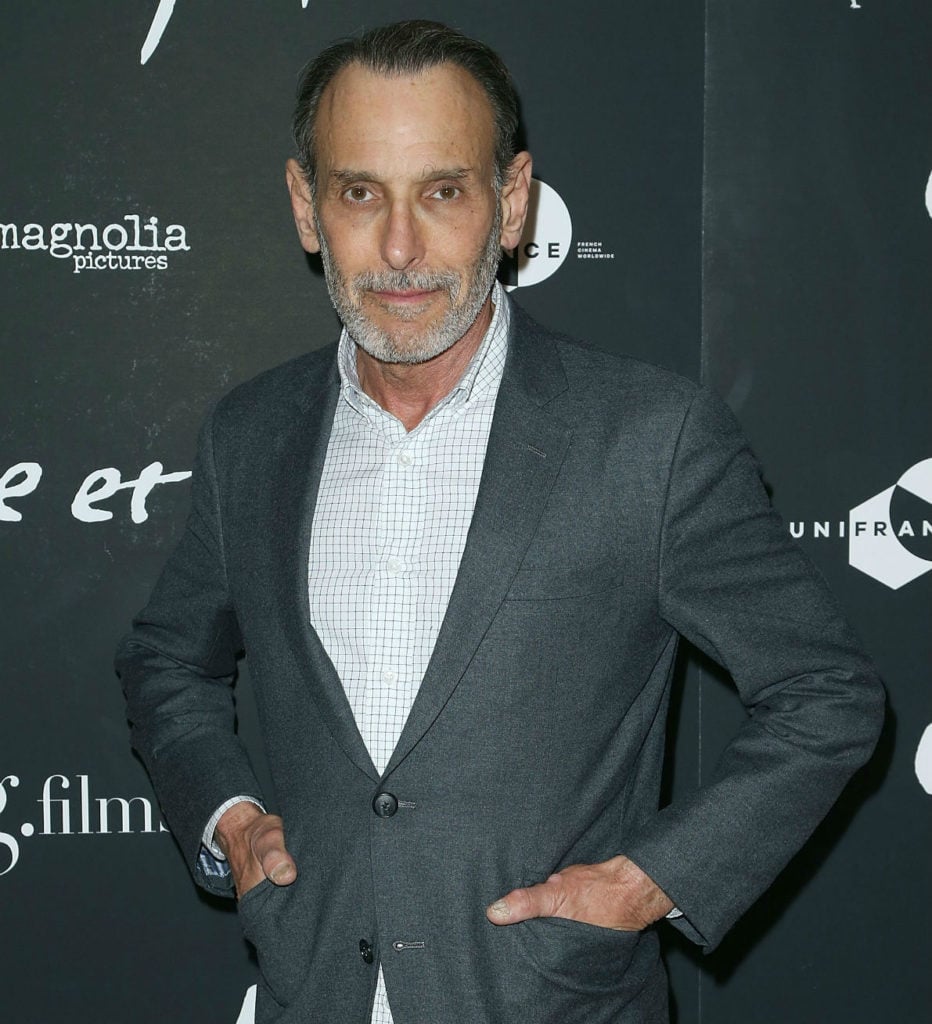
His new show at Skarstedt sees the New York painter refining his theories of "how to see."

David Salle’s career has spanned over four decades. Known as one of the major lights of “postmodern painting,” he conjures swirling masses of imagery culled from many sources.
He also happens to be a very sharp observer of his fellow artists, and his writings culminated in a recent book, authoritatively titled How to See: Looking, Talking, and Thinking About Art (W.W. Norton, 2016). It won praise from fans including Hilton Als and Salman Rushdie.
Where have these acute reflections on the craft of painting taken Salle now? New York’s Skarstedt gallery is currently offering a glimpse of his latest, in a show titled “Ham and Cheese and Other Paintings.” It features new paintings that layer painted passages with imagery culled mainly from advertising.
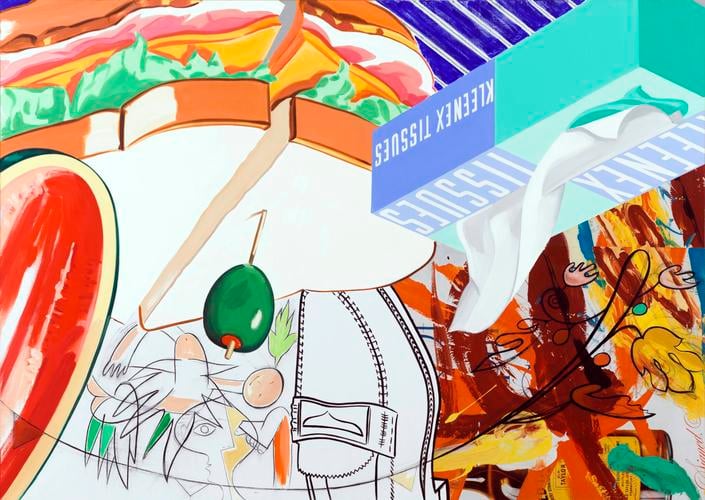
David Salle, Ham and Cheese (2017). © David Salle/Licensed by VAGA. Image courtesy of the artist and Skarstedt.
artnet News sat down with the artist to discuss both what it means to start painting small works late in his career, and how writing has become an important part of his artistic practice.
I guess we can start off with this new body of work. How did it come about? What was the inspiration?
I don’t know if I can pin-point one thing. My way of building a picture always seems to be evolving. Sometimes it moves faster than others. It sounds sort of vague to put it into words but I wanted to make an “open” type of painting, whatever that means. One with a lot of air in it. Another thing that happened is that I’m using a new kind of paint for some of the passages: Flashe, which has been around forever but isn’t used so much here.
Right. And it’s not an oil-based paint, correct?
It’s poster paint for grownups. It gives you a very matte surface and highly saturated color.
And how did you come to it? Had you worked with it before?
I’ve always liked a really matte surface, but usually you have to use additives, like wax, to get it. This paint is dead matte and also comes in a great color range. Once I discovered that, it was off to the races.
Focusing on some of the changes in your work, you have a collection in the downstairs gallery of these smaller paintings, which is something new for you. You’re known for making large paintings, for the most part. What was the impetus for showing these smaller works?
I’ve always gravitated toward this large scale—what used to be called the “New York School” scale. I love the challenge of making a big painting, one that you have to enter into, where you can’t take in everything in one glance. This type of painting has its own internal rhythm, and your eye moves around in it along certain pathways, at varying speeds, accruing bits of information along the way.
That’s always been my orientation to painting. I arrived at this way of looking early on, and it allowed me to develop a personal sense of composition and structure. In a way, it’s been the driving force behind my painting all along. As a result, I’ve made relatively few paintings over the years below a certain size. That all changed in the last couple of years. I don’t really know why. Now, there’s a reciprocity between the bigger and smaller paintings, and I wanted to show it.
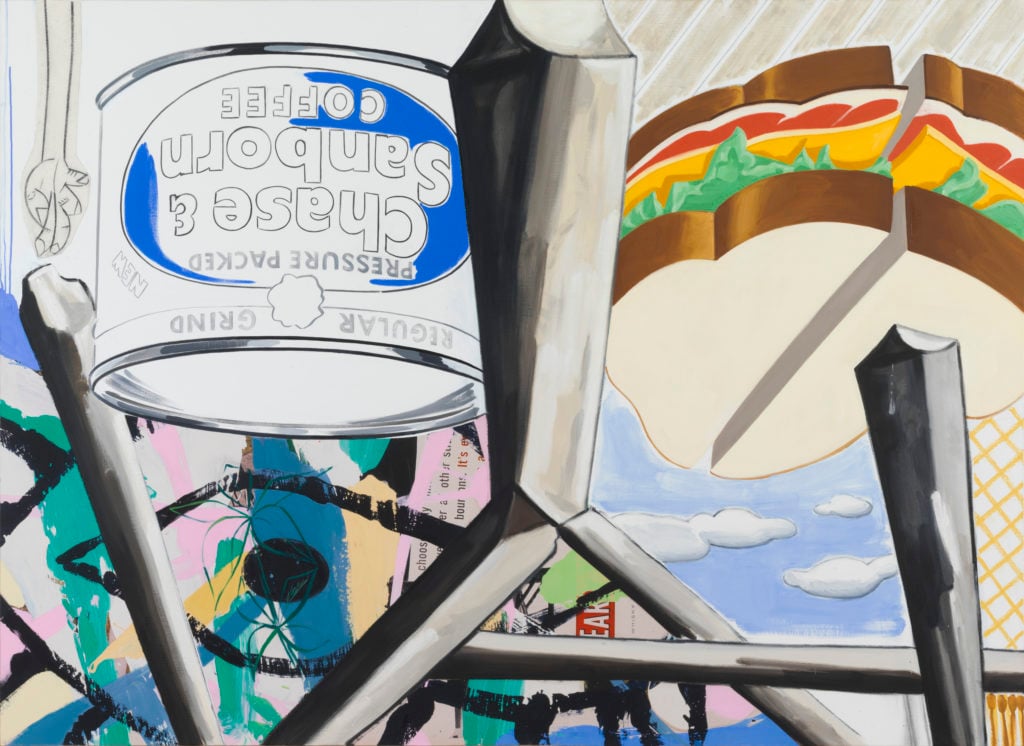
David Salle’s The Old Bars (After MH) (2017). © David Salle/Licensed by VAGA. Image courtesy of the artist and Skarstedt.
These paintings seem very intimate. They also feel quite intentional or experimental in some way. I’m assuming you’re doing them very quickly.
Some are done quickly; others take longer. It’s good if they look like not too much effort was expended, even if they might have taken a while.
I’ve heard your new body of work described as spiritually akin to “later Don DeLillo,” which I thought was such an interesting way to talk about your work, to compare works of painting to literature.
That’s interesting because Don was just in the gallery and told me he liked the show.
It made me think of your book How to See, which came out almost a year ago now. There you talk about painting and writing or literature as having the same spirit. I was wondering if you could speak to that relationship, considering that you are both a writer and painter.
Writing and painting are very different on most levels, but I do think my writing has been beneficial to my painting. Writing about other people’s work is a great exercise. It focuses your attention on the specifics of painting. In conversation, we tend to generalize.
On some level How To See came out of a necessity to highlight the artist’s perspective as opposed to a more academic one, giving insights into how to look and talk about art that’s not so much reliant on ideas, but really about the work itself.
Well, I don’t think it’s not about ideas. It’s about the relationship of ideas to form. Ideas in and of themselves—or what passes for ideas—are often like empty calories. Some of the things that pass for ideas today are just cultural prejudices; they don’t hold up very well to scrutiny.
I think the way to approach most art is not that different from how we approach other people. We’re all pretty good at it. It takes about 30 seconds to have an opinion about someone. Of course, you have to be honest about it, and you can be wrong; you can revise your opinion. Works of art are similar, in terms of our relationship to them.
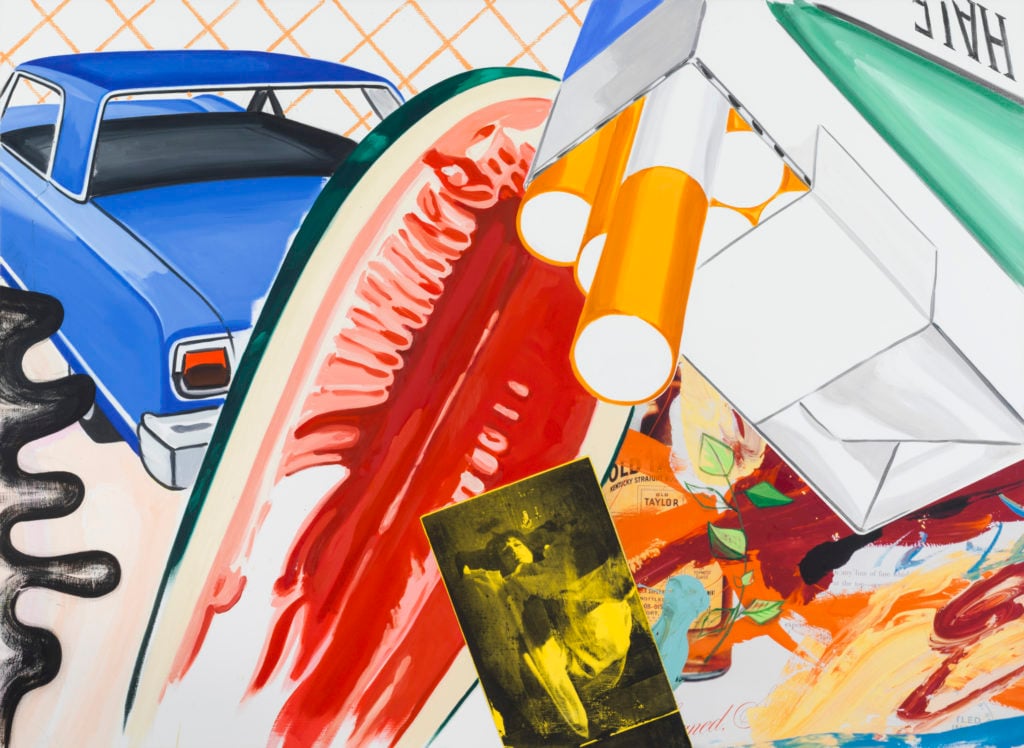
David Salle’s Portrait of Beverly (2017). © David Salle/Licensed by VAGA, New York, NY. Image courtesy of the artist and Skarstedt.
That’s very interesting, that idea of honesty.
When I teach, the first task is to try to get people to acknowledge what it is they are actually feeling or thinking about a work of art, which is often quite distinct from what they feel they’re supposed to be thinking.
Are you thinking that way at all when you’re making your own work? Another way to ask that question is, how would you write about your own work?
Of course, in general, that perspective applies to one’s own work—it’s called self-criticality or distance. I haven’t written about my own work in the same way that I’ve written about others, though.
Do you have any interest in writing about yourself?
I probably will do it eventually. We’ll see.
I want to get back to the new work. I know you were talking about how you don’t really see it as so much as a departure from your earlier work, but I was hoping you could talk about the differences. Something that struck me is that there seems to be an absence of a figure in most of these works.
Even if it wasn’t a conscious plan, I have made painting in all the so-called classical genres: figure, portrait, landscape, still life, and history painting. Some I just dabbled in, but my roots are in some kind of descriptive painting that locates a figure in a context, in a landscape or maybe in a psychological landscape.
Some of these new paintings, especially the smaller ones, are something of a return to more direct painting of the figure, but I’m really a compositional painter. I’m interested in a number of things, and work with various processes, of which so-called direct painting is one, but the idea of compositional organization is paramount.
This approach makes me a bit of an odd man out. In the last 40 or 50 years painting has moved, generally speaking, in a counter-direction.
Are you saying that there are not that many younger artists playing that game?
I don’t really know, but I suspect that it’s no longer part of the curriculum, so to speak, at least not in the same way. I think compositional painting has been assigned, in the art press, only one meaning, which is to represent the cacophony of modern culture.
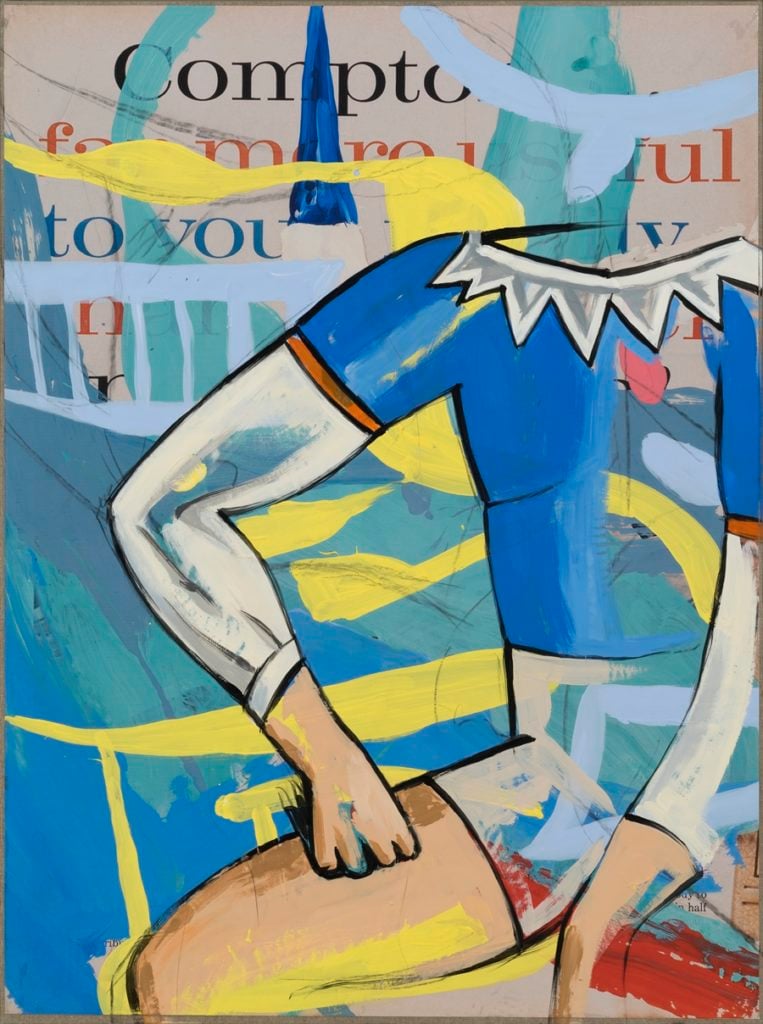
David Salle’s Circus (2017).
© David Salle/Licensed by VAGA, New York, NY.
Image courtesy of the artist and Skarstedt, NY.
[Laughter]
Laughter is the appropriate response. There is so much more to it—to life—than that. It has more to do with a sense of time, with simultaneity, and rhythm, internal rhythm, musical structure, and narrative structure. In other words, it’s experiential, not just representational.
I think a good painting does about 12 things simultaneously. But maybe not all of them equally, all the time.
I wanted to get a sense of your process in general, your day-to-day. When it comes to these smaller paintings, do they relate in any way your larger paintings?
The smaller ones feed into the larger ones, and vice versa. When it comes to subject matter, I usually start with one image that interests me.
And those images come from objects around you?
Well, they’re two types of things. Some of them are from life: the flowers and leaf shapes, the figures and portrait. But most of these images appeared first as ads. They’re part of a presentational vocabulary that was encoded in the popular vernacular of the 1950s and ’60s.
That period also coincides with my personal youth—so maybe there is something there. I don’t think it’s nostalgia, but the look is something I’m familiar with. It’s something I can use. These images say, “Look at this!” They’re very declarative. And I think that’s interesting from a pictorial standpoint.
There’s a painting in the show [Jantzen (2015–17)] that depicts a tower of tomatoes balanced on top of each other, like a leaning tower of Pisa, only with tomatoes. It’s kind of a brilliant pictorial idea. Some art director thought it up in 1958 for a ketchup ad. It’s brilliant visual logic that I’d be crazy not to use.
I’m curious. Are you looking at different types of source materials? I imagine you’re looking at actual old magazines, but do you use the internet at all?
No, I don’t use the internet for source material. I don’t dislike it, but it encourages the idea that all images are inherently interesting or are more or less equal, and the more un-differentiated the better, which is just not my point of view.
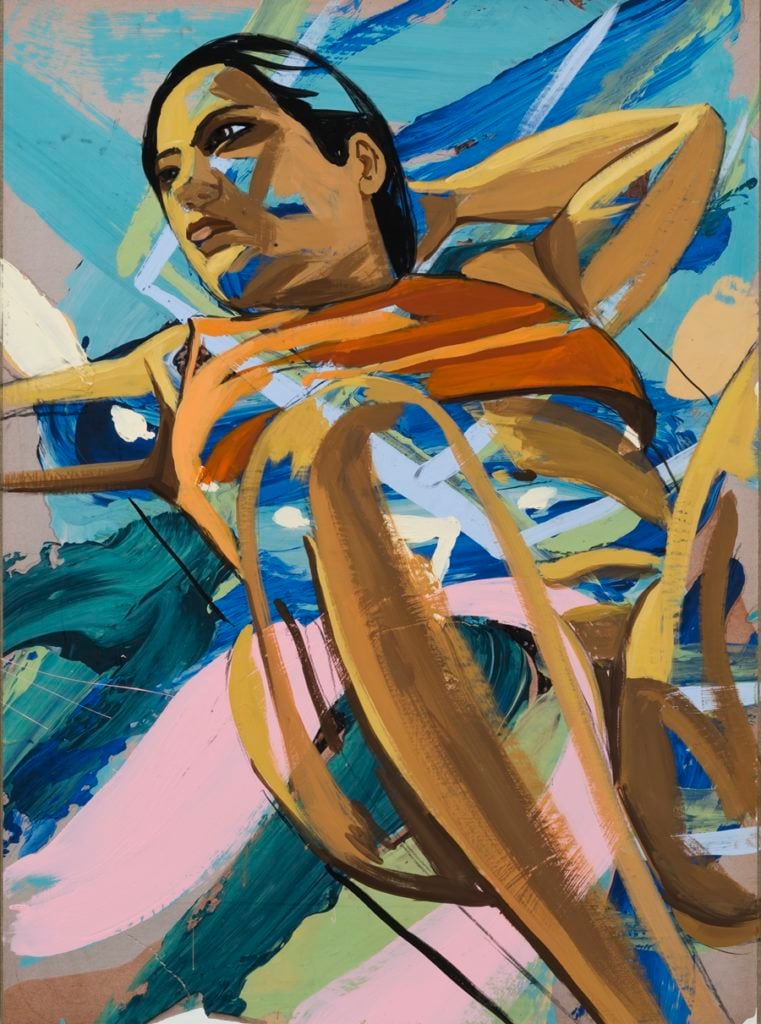
David Salle’s Look (2017). © David Salle/Licensed by VAGA, New York, NY.
Image courtesy of the artist and Skarstedt.
Do you feel painters are more equipped to write about a painting? Or do you feel that because you’re a painter that makes you a better art writer?
Only in the sense that a painter will notice certain things that may escape other writers’ attention. But what I’m interested in is writing, in prose. The fact that I’m an artist gives me a subject.
For example, my writing has been influenced by, among many others, Red Smith and A.J. Liebling, both of whom were sports writers. He’s long dead now, but Red Smith was the lead sports writer for the New York Times for decades. You can still read him today. It’s not that we’re so interested in baseball games that were played 50 years ago, but Smith’s dramatization of the game is a literary pleasure. He’s the Thucydides of baseball.
“David Salle: Ham and Cheese and Other Paintings” is on view at Skarstedt Gallery, New York, September 14–October 28, 2017.